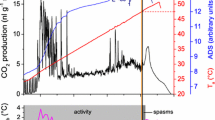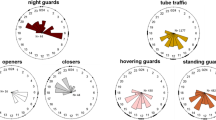Abstract
Paper wasps, like Polistes dominula, are considered as primitively eusocial. Hence, they are often used as model species for studies about the evolution of eusociality and dominance hierarchies. However, our knowledge about basic physiological processes in these wasps remains limited. In particular, the thermoregulation of individual wasps in their natural habitat has not yet been investigated in detail. We conducted a comprehensive field study to test their ability to respond to external hazards with elevated thorax temperatures. We presented artificial threats by applying smoke or carbon dioxide simulating fire and predator attacks, respectively, and monitored the thorax temperature of wasps on the nest using infrared thermography. We found that P. dominula workers recognized smoke and CO2 and reacted almost instantaneously and simultaneously with an increase of their thorax temperature. The maximal thorax temperature was reached about 65 s after the application of both stressors, but subsequently, the wasps showed a different behaviour pattern. No rise of the thorax temperature was detectable after an air blast was applied or in wasps resting on the nest. These observations provide evidence that P. dominula is able to heat up its thorax and that thermoregulation is employed in escape and defence reactions. Additionally, we investigated the thorax temperatures of queens during dominance battles. We found that the thorax temperature of the dominant queens rose up to 5 °C compared to that of subordinate queens that attacked the former, suggesting that the dominant queen defends herself as well as her nest.




Similar content being viewed by others
References
Coelho JR (2001) Behavioral and physiological thermoregulation in male cicada killers (Sphecius speciosus) during territorial behavior. J Therm Biol 26:109–116
Coelho JR, Ross AJ (1996) Body temperature and thermoregulation in two species of yellowjackets, Vespula germanica and V. maculifrons. J Comp Physiol B 166:68–76
Field J, Solis CR, Queller DC, Strassmann JE (1998) Social and genetic structure of paper wasp cofoundress associations: tests of reproductive skew models. Am Nat 151:545–563
Gamboa GJ, Noble MA, Thom MC, Togal JL, Srinivasan R, Murphy BD (2004) The comparative biology of two sympatric paper wasps in Michigan, the native Polistes fuscatus and the invasive Polistes dominulus (Hymenoptera, Vespidae). Insect Soc 51:153–157
Heinrich B (1979) Thermoregulation of African and European honeybees during foraging, attack, and hive exits and returns. J Exp Biol 80:217–229
Heinrich B (1984) Strategies of thermoregulation and foraging in two vespid wasps Dolichovespula maculata and Vespula vulgaris. J Comp Physiol B 154:175–180
Heinrich B (1993) Hot blooded insects: strategies and mechanisms of thermoregulation. Harvard University Press, Harvard
Hozumi S, Yamane S (2001) Incubation ability of the functional envelope in paper wasp nests (Hymenoptera, Vespidae, Polistes): I field measurements of nest temperature using paper models. J Ethol 19:39–46
Hunt JH (2006) Evolution of castes in Polistes. Ann Zool Fenn 43:407–422
Jandt JM, Tibbetts EA, Toth AL (2014) Polistes paper wasps: a model genus for the study of social dominance hierarchies. Insect Soc 61:11–27
Jones JC, Oldroyd BP (2007) Nest thermoregulation in social insects. Adv Insect Physiol 33:153–191
Kleineidam C, Romani R, Tautz J, Isidoro N (2000) Ultrastructure and physiology of the CO2 sensitive sensillum ampullaceum in the leaf-cutting ant Atta sexdens. Arthropod Struct Dev 29:43–55
Klingner R, Richter K, Schmolz E, Keller E (2005) The role of moisture in the nest thermoregulation of social wasps. Naturwissenschaften 92:427–430
Klingner R, Richter K, Schmolz E (2006) Strategies of social wasps for thermal homeostasis in light paper nests. J Therm Biol 31:599–604
Kovac H, Schmaranzer S (1996) Thermoregulation of honeybees (Apis mellifera) foraging in spring and summer at different plants. J Insect Physiol 42:1071–1076
Kovac H, Stabentheiner A (1999) Effect of food quality on the body temperature of wasps (Paravespula vulgaris). J Insect Physiol 45:183–190
Kovac H, Stabentheiner A, Schmaranzer S (2009) Thermoregulation of water foraging wasps (Vespula vulgaris and Polistes dominulus). J Insect Physiol 55:959–966
Lacher V (1967) Verhaltensreaktionen der bienenarbeiterin bei dressur auf kohlendioxid. Z vergl Physiol 54:75–84
Liebert AE, Gamboa GK, Stamp NE, Curtis TR, Monnet KM, Turillazzi S, Starks PT (2006) Genetics, behaviour and ecology of a paper wasp invasion: Polistes dominulus in North America. Ann Zool Fenn 43:595–624
Nonacs P, Liebert AE, Starks PT (2006) Transactional skew and assured fitness return models fail to predict patterns of cooperation in wasps. Am Nat 167:467–480
Pardi L (1996) Polistes: analysis of a society. In: Turillazzi S, West-Eberhard MJ (eds) Natural history and evolution of paper-wasps. Oxford University Press, Oxford, pp 1–17
Queller DC, Zacchi F, Cervo R, Turillazzi S, Henshaw MT, Santorelli LA, Strassmann JE (2000) Unrelated helpers in a social insect. Nature 405:784–787
Reeve HK (1991) Polistes. In: Ross KG, Matthews RW (eds) The social biology of wasps. Cornell University Press, Ithaca and London, pp 99–148
Reeve HK, Starks PT, Peters JM, Nonacs P (2000) Genetic support for the evolutionary theory of reproductive transactions in social wasps. Proc R Soc Lond B Biol Sci 267:75–79
Schmaranzer S, Stabentheiner A (1988) Variability of the thermal behaviour of honeybees on a feeding place. J Comp Physiol B 158:135–141
Seeley TD (1974) Atmospheric carbon dioxide regulation in honey-bee (Apis mellifera) colonies. J Insect Physiol 20:2301–2305
Stabentheiner A, Schmaranzer S (1987) Thermographic determination of body temperatures in honey bees and hornets: calibration and applications. Thermology 2:563–572
Steiner A (1930) Die Temperaturregulierung im Nest der Feldwespe (Polistes gallica var. biglumis L.). Z vergl Physiol 11:461–502
Tibbetts EA, Reeve HK (2003) Benefits of foundress associations in the paper wasp Polistes dominulus: increased productivity and survival, but no assurance of fitness returns. Behav Ecol 14:510–514
Weidenmüller A, Kleineidam C, Tautz J (2002) Collective control of nest climate parameters in bumblebee colonies. Anim Behav 63:1065–1071
Weiner SA, Woods WA Jr, Starks PT (2009) The energetic costs of stereotyped behaviour in the paper wasp, Polistes dominulus. Naturwissenschaften 96:297–302
Weiner SA, Upton CT, Noble K, Woods WA Jr, Starks PT (2010) Thermoregulation in the primitively eusocial paper wasp, Polistes dominulus. Insect Soc 57:157–162
Weiner SA, Noble K, Upton CT, Woods WA Jr, Starks PT (2011) A role for thermoregulation in the Polistes dominulus invasion: a comparison of the thermoregulatory abilities of the invasive wasp P. dominulus and the native wasp P. fuscatus. Insect Soc 58:185–190
Weiner SA, Galbraith DA, Adams DC, Valenzuela N, Noll FB, Grozinger CM, Toth AL (2013) A survey of DNA methylation across social insect species, life stages, and castes reveals abundant and caste-associated methylation in a primitively social wasp. Naturwissenschaften 100:795–799
West MJ (1967) Foundress associations in polistine wasps: dominance hierarchies and the evolution of social behaviour. Science 157:1584–1585
West-Eberhard MJ (1969) The social biology of polistine wasps. Misc Publ–Mus Zool, Univ Mich 140:1–101
West-Eberhard MJ (2006) Polistine passions. Ann Zool Fenn 43:387–389
Woods WA, Heinrich B, Stevenson RD (2005) Honeybee flight metabolic rate: does it depend upon air temperature? J Exp Biol 208:1161–1173
Acknowledgments
The authors are very grateful to Prof. Dr. Hildburg Beier for the helpful discussions and productive comments on the manuscript. The authors would also like to thank Dr. Johannes Spaethe for the most helpful discussions. Thanks to Prof. Dr. Hans J. Gross for the critical reading of the manuscript and to Shawn Kennedy for the language support. We are grateful to anonymous reviewers for their critical and helpful suggestions. N. H. was supported by a grant of the German Excellence Initiative to the Graduate School of Life Sciences, University of Würzburg.
Ethical standards
The authors declare that the experiments performed in this study comply with the current laws of Germany.
Conflict of interest
The authors declare that they have no competing interests.
Author information
Authors and Affiliations
Corresponding author
Additional information
Communicated by: Sven Thatje
Rights and permissions
About this article
Cite this article
Höcherl, N., Tautz, J. Thermoregulation of individual paper wasps (Polistes dominula) plays an important role in nest defence and dominance battles. Sci Nat 102, 32 (2015). https://doi.org/10.1007/s00114-015-1283-6
Received:
Revised:
Accepted:
Published:
DOI: https://doi.org/10.1007/s00114-015-1283-6




